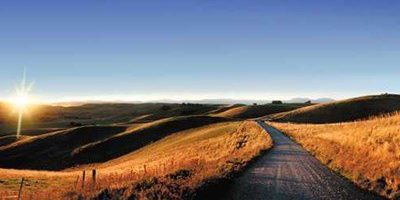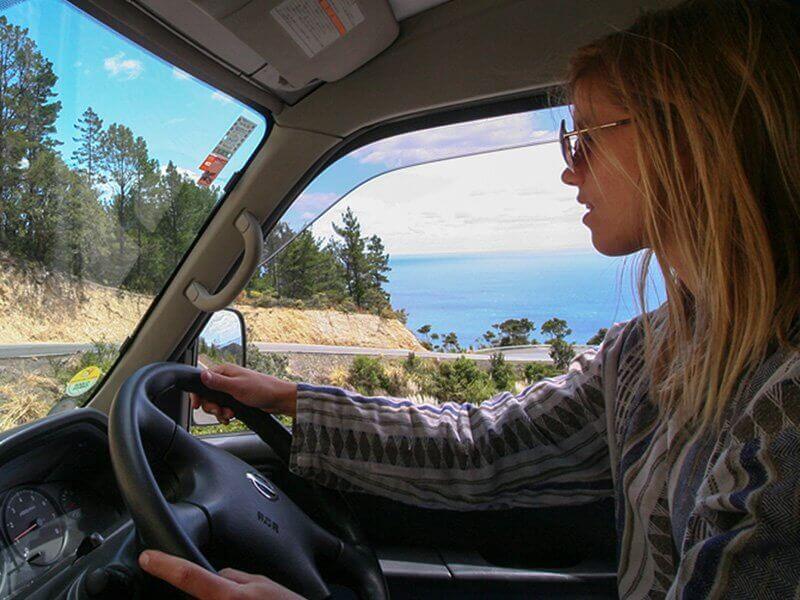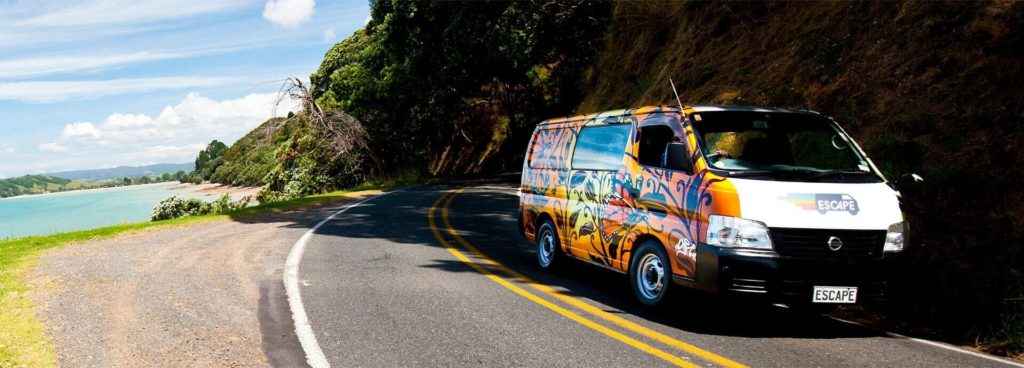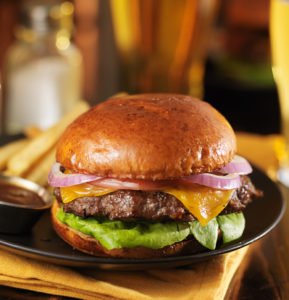Terms and Conditions
We try to be as open and transparent as possible, so please read our full/detailed terms and conditions below. Alternatively, please download a pdf version of our terms and conditions.
‘C’ – ESCAPE RENTALS LIMITED (operator of Escape / Hugo Campervans and Hugo Rental Cars) TERMS AND CONDITIONS OF HIRE
1. VEHICLE
1.1 The owner will let and the hirer will hire the motor vehicle described in the associated Rental Agreement.
2. PROVISION OF VEHICLE
2.1 The owner will provide the vehicle in a roadworthy condition and pay for all tyres, batteries and mechanical repairs required during the hire period arising from fair wear and tear providing reasonable care has been taken by the hirer and the hirer has complied with all these terms and conditions and the Rental Agreement.
2.2 All existing damage to the vehicle is recorded in the Rental Agreement and acknowledged by the parties.
3. DURATION OF HIRE
3.1 The term of hire shall be for the calendar days stated in the Rental Agreement. Vehicle collections or drop offs outside the times and periods or locations detailed in the rental agreement will incur a fee not exceeding $1000.
4. PERSONS WHO MAY DRIVE VEHICLE
4.1 The vehicle may be driven during the period of hire only by authorised drivers, who are persons holding a current full driver’s licence valid in New Zealand (translated into English language where applicable) and appropriate for the vehicle, and who are named on the Rental Agreement.
5. PAYMENTS BY HIRER
5.1 The hirer shall pay to the owner:
(a) the rental charges for the hire of the vehicle for each day the vehicle is in the hirer’s possession. A surcharge may apply if the hirer or any authorised driver is under 22 years of age;
(b) the insurance excess specified in the Rental Agreement or the excess waiver amount on a per incident basis, payable at the commencement of the hire period and on the date of every accident or incident of loss or damage thereafter. Each subsequent excess waiver payment shall be proportionate to the number of days remaining of the hire period; and
(c) any penalties relating to freedom camping, parking and/or traffic offences specific to the period of hire together with an administration fee of $75.00 in respect of each infringement.
(d) any penalties relating to the late collection, or return of the vehicle or any penalties where the vehicle has been returned to a location which is not agreed within the rental agreement.
(e) an insurance documentation processing fee of $50 when a vehicle is damaged and insurance has been exercised (excluding windscreen damage). Any payment under clause 5.1(b) or 5.1(c) can be deducted from the hirer’s security deposit or transacted directly on the hirer’s credit card.
5.2 Where there is more than one hirer, each hirer is jointly and severally liable for all obligations of the hirer pursuant to this Agreement.
5.3 The hirer will be liable for a late payment penalty of 10% (compounded daily) of the total amount due to the owner, together with any costs incurred in respect of collection of the amount due (including but not limited to legal costs, administration and debt collection costs). Such penalty will begin to accrue on the expiry of 14 days from the due date for payment.
6. HIRER’S OBLIGATIONS
6.1 The hirer shall:
(a) pay for all petrol used in the vehicle during the period of hire;
(b) ensure that the water in the radiator and battery and the oil in the vehicle are maintained at the proper level and that the tyres are maintained at the proper pressure;
(c) ensure all reasonable care is taken in handling and parking the vehicle and that it is left securely locked when not in use;
(d) ensure that the vehicle’s distance recorder or speedometer are not interfered with;
(e) ensure that no part of the vehicle’s engine transmission, braking, or suspension systems are interfered with; and
(f) stop driving the vehicle and advise the owner immediately if a warning light is illuminated or the hirer believes that the vehicle requires mechanical attention.
6.2 The hirer will be liable for all damage, costs and expenses associated with any careless or negligent use of the vehicle, including but not limited to damage arising from failure to ensure appropriate levels of petrol, oil or water are maintained.
7. MECHANICAL REPAIRS AND EQUIPMENT FAILURE
7.1 The hirer will notify the owner and the owner’s roadside assistance representative of any mechanical irregularity immediately. The hirer shall not arrange or undertake any repairs (including purchase of replacement tyres) without the authority of the owner except to the extent that the repairs are necessary to prevent further damage to the vehicle. The hirer will comply with all reasonable instructions of the owner.
7.2 The owner will be responsible for repairs or damage arising directly or indirectly from fair wear and tear of the vehicle.
7.3 Subject to clause 7.2, in the event of a mechanical breakdown, the owner will, at the owner’s discretion, either:
(a) provide a replacement vehicle, subject to vehicle availability or
(b) refund the balance of the rental value, excluding insurance, for the period when the vehicle was unable to be used; or
(c) provide compensation for budget accommodation to a maximum of $50.00 per vehicle per day or
(d) extend the hire period to account for the period when the vehicle was unable to be used. where a campervans living equipment has failed (e.g. accessories or campervan appliances), the hirer shall contact the owner to discuss options available which may include:
(a) The hirer purchasing replacement equipment to an agreed/ authorised cost, which will be reimbursed upon completion of hire.
(b) The owner providing replacement equipment.
(c ) The owner reimbursing the client an agreed level of compensation.
In all instances, the owner will exercise one of the three options listed above, only during the hire and at the time the equipment failure/fault has been reported. The owner accepts no liability for equipment failure if it is only reported at the end of the rental agreement period.
7.4 Without limiting any other provision of this agreement, in the event of a mechanical breakdown, if a replacement vehicle is not available or accessible to the hirer, the owner will not be liable for any personal expenses or costs associated with any missed activities or accommodation.
8. ACCIDENTS
In the event of any accident or incident involving the vehicle, the hirer must:
8.1 – Notify the appropriate New Zealand Emergency Service (Ambulance, Police, Fire) immediately by phoning ‘111’ if the accident or incident involves injury.
8.2 – Notify the owner and advise the full situation and circumstances as soon as practicable and in any event, within of 24 hours from the time of the accident or incident.
8.3 – Record full details of all parties, witnesses to and vehicles involved in the incident or accident.
8.4 -Prepare a written statement of the facts signed by all parties, complete insurance documentation and obtain a copy of any relevant police report. In the event of any accident or incident involving the vehicle, the hirer must not:
8.5 – Make any admission of liability; or
8.6 – Arrange to undertake any repairs or salvage without the owners prior authority, except to the extent that repairs or salvage are necessary to prevent any further damage to the vehicle and/or to other property.
8.7 The availability of a replacement vehicle is not guaranteed and is at the owner’s discretion, subject to availability, hirer’s location, accident circumstances and accident liability. Refunds for unused days or replacement vehicle requirements resulting from an accident or incident are at the sole discretion of the owner. Additional hirer charges may be incurred including as follows:
8.8 If a replacement vehicle is authorised by the owner, the hirer is responsible for making their own way back to the appropriate depot or designated location as dictated by the owner.
8.9 The hirer is responsible for the cost of transporting the hirer and any accompanying passengers away from the accident location.
8.10 The owner reserves the right to on-charge towing or salvage expenses to the hirer if it is a single vehicle accident or the accident is due to the hirers error/fault.
8.11 Provided the owner has complied with clause 2.1 the hirer must pay for any costs relating to the delivery of a replacement vehicle. These costs apply irrespective of any excess waiver insurance applicable to this agreement.
8.12 In the event that a replacement vehicle is given due to an accident, any insurance coverage or excess waiver insurance is not transferable to the replacement vehicle.
8.13 Without limiting any other provision of this Rental Agreement, in the event of an accident, if a replacement vehicle is not available or accessible to the hirer, the owner will not be liable for any resulting accommodation or living expenses that are incurred, nor personal expenses for missed activities unless such an accident has been caused by or contributed to by breach of this Rental Agreement or the negligent act, error or omission of the owner. No replacement vehicle will be provided without receipt of a completed damage claim form where one is required by the owner. An additional Insurance/Damage Administration fee of $50 (inclusive of GST) will be applied for processing insurance/damage claims. This fee applies to all damage claims regardless of whether the hirer elects to use excess waiver insurance or has made their own travel insurance arrangements. This fee may be refunded if it is proven that the damage was not due to the hirer’s behaviour or fault. No replacement vehicle will be provided and the Rental Agreement will be cancelled if any of the insurance exclusions detailed within clause 9.2 are exercised.
9. INSURANCE
9.1 Indemnities: Subject to the exclusions set out below, the hirer and any authorised driver are:
(a) fully indemnified in respect of any liability he or she might have to the owner in respect of the loss or damage to the vehicle and its accessories and spare parts and any consequential loss of revenue or other expenses of the owner including towing and salvage costs associated with recovery of the vehicle, subject to the clauses set out in section 8; and
(b) indemnified to the extent of $1,000,000.00 in respect of any liability he or she might have for damage to any property (including injury to any animal) belonging to any person and arising out of the use of the vehicle.
9.2 Exclusions: The indemnities set out in clause 9.1 above shall not apply where the relevant damage, injury or loss arises in circumstances where:
(a) The driver of the vehicle is under the influence of alcohol or drugs affecting his or her ability to drive;
(b) The driver of the vehicle drives illegally or commits an offence while driving the vehicle;
(c) The vehicle is in an unsafe or unroadworthy condition which arose during the hire period and which caused or contributed to the damage or loss and the hirer or driver was or ought to have been aware of the unsafe or unroadworthy condition of the vehicle;
(d) The vehicle is driven with more than stipulated occupants i.e. 3 occupants for campervans and 5 occupants for rental cars;
(e) The vehicle is wilfully or recklessly damaged by the hirer or any authorised driver, or is lost as a result of wilful, negligent or reckless behaviour of any such person;
(f) The vehicle is operated in any race, speed test, rally or contest or operated on any race or rally circuit;
(g) The vehicle is driven by any person other than the hirer or an authorised driver;
(h) The vehicle is operated in a careless or negligent manner, including but not limited to allowing the engine to overheat, incorrect use of gears, use of incorrect fuel, becoming locked out of vehicle, “bogging” of vehicle or any non-compliance with clause 6.1;
(i) The vehicle is operated on any of the following roads and locations: Tasman Valley Road (Mt Cook), Skippers Canyon (Queenstown), Ninety Mile Beach, North of Colville township (Coromandel), or any beach site or other areas specified by the owner from time to time. It is also an exclusion (unless option ‘C’ – full insurance cover is purchased) on any unformed or unsealed roads. Note. If the vehicle is parked at any ski field, the designated parking area must be used;
(j) The vehicle keys have become lost, broken or damaged, stolen or of retrieval of keys which have been locked in the vehicle, or the vehicle has been stolen due to it being unlocked. All costs associated with replacement keys (including roadside assistance/call out costs) are therefore the responsibility of the hirer.
(k) Any damage or loss caused to any personal belongings in the vehicle
(l) There is a breach of any of these terms and conditions or the Rental Agreement, and in any of such circumstances the hirer will be liable for all costs associated with any incident, including but not limited to the full replacement or repair cost of the vehicle and any third party damage.
9.3 No insurance applies to personal property of the hirer or contents of the vehicle and the hirer will be responsible for all damage to the interior of the vehicle and to all damage to or loss of all property of the owner, including any documents related to the vehicle, except where such damage is a result of a vehicular collision to the extent that insurance (and any applicable excess) shall apply.
9.4 Where any loss or damage is not covered by insurance, the amount due by the hirer in respect of such loss or damage is payable by the hirer from the date such loss or damage occurred.
9.5 It is agreed between the owner and the hirer that section 11 of the Insurance Law Reform Act 1977 shall apply with respect to the above exclusions as if this clause constituted a contract of insurance. In general this provision means that an exclusion will not apply if the hirer proves on the balance of probability that the damage or loss was not caused or contributed to by the matters referred to under the exclusion clause. The hirer acknowledges by signing the Rental Agreement that the hirer is aware of the above exclusions.
9.6 Rejection of Excess Waiver Insurance: If excess waiver insurance (option B or option C) is rejected, the hirer accepts by signing the Rental Agreement that:
(a) the vehicle is hired at the hirer’s own risk in respect of loss or damage to the vehicle and consequential loss by the owner;
(b) he or she has no excess waiver insurance cover under this agreement in respect of any damage, injury, or loss caused to any person or property,
(c) he or she may be liable to the owner for damage to or loss of the vehicle and consequential loss; and he or she may be liable for the higher ‘single vehicle incident’ excess, which is an additional charge of $1,000 over and above the $3,000 bond (campervans) or $2000 bond (rental cars).
9.7 Excess and excess waiver:
(a) In the event of an accident the hirer is responsible for ensuring that the correct insurance forms are fully completed. The owner will take no responsibility for the hirer’s failure to do so or any lack of insurance cover arising from such failure.
(b) In the event of an accident, the excess amount will be charged to the hirer by the owner regardless of who is at fault. The excess amount will be reimbursed to the hirer where a third party is deemed by the owner’s insurance company to be at fault and repair costs have been recovered from the third party or that party’s insurer.
(c) Where an accident or damage involves a third party, the hirer will be liable for the excess amount (regardless of who is at fault) if: the hirer fails to obtain the full and correct contact details of the third party; or it is not possible to obtain the insurance excess amount from the third party.
(d) The owner will hold the excess amount (or the credit card payment slip for the excess amount) for a period of 42 days from the date the vehicle is returned and where no excess is required to be paid in respect of any loss or damage or fines incurred, the owner will then refund the excess amount to the hirer or ensure the credit card payment slip is not processed.
(e) Where the hirer has chosen the excess waiver option and damage or loss has occurred to the vehicle but the hirer has not reported such damage to the owner, the owner may for insurance purposes deem that such damage occurred on the first day of the hire period;
(f) Where the actual cost of repair or replacement for loss or damage is less than the excess amount, the owner will refund the difference to the hirer once the relevant costs have been established.
10. ACCESSORIES
The owner holds your request for accessories with your reservation, however cannot guarantee availability until rental pickup. Reliability of directions provided by GPS units is not guaranteed. The hirer is responsible for all costs in the event of lost, stolen or damaged accessories and/or any
of their components. The renter agrees to release and hold the owner harmless for any GPS unit failures.
11. USE OF THE VEHICLE
11.1 The hirer shall not:
(a) Sublet or hire the vehicle to any other person;
(b) Permit the vehicle to be operated outside his or her authority;
(c) Operate the vehicle or permit it to be operated in circumstances that constitute an offence by the driver against any of sections 56, 57 and 58 of the Land Transport Act 1998 (which relates to driving under the influence of drink or drugs);
(d) Operate the vehicle or permit it to be operated in any race, speed test, rally or contest, or operated on any race or rally circuit;
(e) Operate the vehicle or permit it to be operated in breach of the Transport Act 1962, the Land Transport Act 1998, the Traffic Regulations 1976, or any other Act, regulations, rules or bylaws relating to road traffic;
(f) Operate the vehicle or permit it to be operated for the transport of more than the number of passengers or more than the weight of goods specified in the certificate of loading for the vehicle;
(g) Drive or allow the vehicle to be driven by any other person if at the time of driving the vehicle the driver does not hold a current full valid driver’s licence appropriate for the vehicle;
(h) Operate the vehicle or permit it to be operated to propel or tow any other vehicle;
(i) Transport any animal in the vehicle (with the exception of guide dogs for visually impaired people);
(j) Operate the vehicle on any of the roads set out in clause 9.2j park the vehicle in any area of a ski field not designated as a car park.
(k) Smoking in the vehicle will be deemed to be soiling the vehicle, in which case the owner reserves the right to charge a minimum cleaning fee of $200.00.
(l) Returning any self-contained campervan without first cleaning the portable toilet will be deemed to be soiling the vehicle also, in which case the owner reserves the right to charge a minimum cleaning fee of $200.00.
12. CANCELLATION OF RENTAL AGREEMENT BY OWNER
The owner reserves the right to cancel the rental agreement (and vehicle hire) when advised by the NZ Police that the vehicle has been witnessed as and /or reported as being driven in an unsafe manner. When this occurs, the hirer must present the vehicle keys to the NZ Police Officer as requested and the vehicle hire will be terminated with immediate effect, without recourse or refund. The hirer is also liable for the towing costs associated with the relocation of vehicle back to the nearest Escape depot. Under these circumstances, the hirer is not entitled to any refunds or compensation.
13. RETURN OF THE VEHICLE
13.1 The hirer shall, at or before the expiry of the term of hire, deliver the vehicle to the agreed rental
location described in the Rental Agreement or obtain the owner’s consent to the continuation of hire. Return to a location other than that specified in the Rental Agreement may incur a fee of up to $1,000 at the owner’s discretion. No refund will be given where the vehicle is returned prior to the scheduled return date.
13.2 The Owner reserves the right to charge a late return fee for any vehicle returned late. The late
return fee will be charged at the full applicable daily rate or part thereof plus any other costs
incurred, including any costs associated with loss of subsequent hire, to a maximum penalty of $1,000.
14. IMMEDIATE RETURN OF VEHICLE WHERE DEFAULT OR DAMAGE OCCURS
14.1 The owner shall have right to terminate the hire and take immediate possession of the vehicle if:
(a) the hirer is in breach of any term of this Agreement;
(b) the hirer has obtained the vehicle through fraud or misrepresentation;
(c) the vehicle is damaged;
(d) the owner reasonably believes that the vehicle has been abandoned;
(e) the vehicle is not returned on the agreed return date or the owner reasonably believes that the vehicle may not be returned on the agreed return date;
(f) the owner considers, on reasonable grounds, that the safety of the hirer, the passengers or the condition of the vehicle is compromised; or
(g) the owner believes, on reasonable grounds, that payment for any charges associated with the hire have not or will not be paid to the owner.
14.2 The termination of the hiring under clause 12.1 shall be without prejudice to the other rights of the owner and the hirer.
14.3 Where the hiring is terminated under clause 12.1, no refund of any part of the rental charges will be given and the hirer will be liable for all reasonable costs of repossessing the vehicle including but not limited to towing costs and any charges imposed by persons whose property is entered onto by the owner for purposes of repossession.
15. INDEMNITY
15.1 Subject to the insurance arrangements agreed with the owner, the hirer hereby indemnifies and shall keep indemnified the owner, its employees or agents against any claims, demands and expenses (including legal costs) incurred or sustained by the owner, its employees or agents or any of them by reason of the hirer’s use and/or possession of the vehicle.
16. PRIVACY ACT
16.1 The hirer acknowledges that the owner will collect, hold and use the hirer’s personal information for purposes related to the hire of the vehicle and the provision of related customer services, including direct marketing and assessing customer satisfaction with products and services of the owner. The hirer further acknowledges that such personal information may be disclosed to debt collection agencies in the event that the hirer defaults in the payment of any monies owing to the owner and the hirer hereby authorises the disclosure of its personal information for such purpose.
17. GOOD AND SERVICES TAX
17.1 The prices featured on this Rental Agreement are inclusive of Goods and Services Tax of 15%




